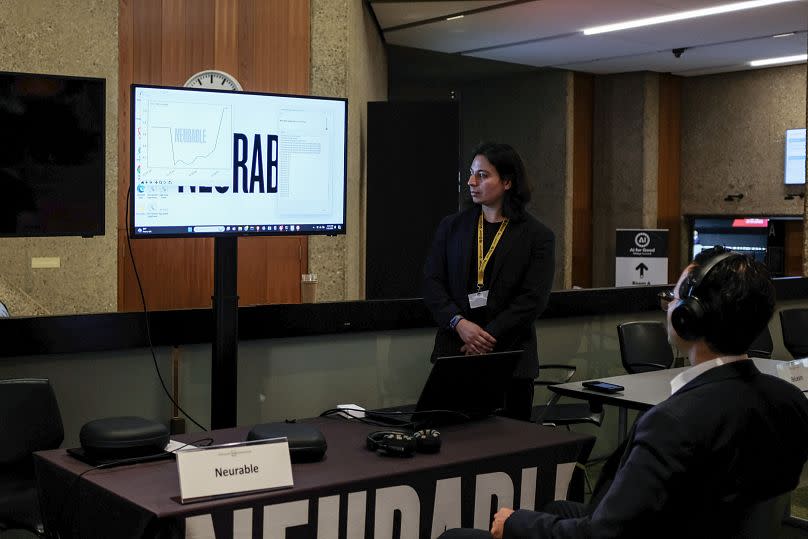When Apple introduced its watch in 2015, the wearable device looked like a gadget. Ten years later, millions of users use heart rate and movement monitoring functions, and some even detect arrhythmia and Parkinson’s disease with this method.
Neurable co-founder Dr. Ramses Alcaide wants us to be able to do the same for our brains.
“It’s crazy that we don’t keep track of the most important organ in our body,” he told Euronews Next. “There are people with Alzheimer’s who didn’t even know they had it until ten years ago. This is crazy and something like this should never happen again.”
While the classic tools for recording brain waves, electroencephalograms (EEG), are bulky, wearable devices that often have more than a hundred sensors, Neurable has spent the last decade creating an EEG device that can fit into a headset.
The company believes that monitoring your brain waves can help you focus and improve your lives, including tracking Alzheimer’s, post-traumatic stress disorder, Parkinson’s disease, fatigue, and even attention-deficit/hyperactivity disorder (ADHD).
How do Neurable headphones work?
The connections between neurons in our brain create electrical activity that increases when we focus. EEGs monitor the activity flowing from our brain to our scalp.
Neurable’s technology uses artificial intelligence to strengthen signals and detect patterns using algorithms. The technology can determine whether someone is focused or not based on their brainwaves.
“Your brain gets tired before your body, but normally you only take a break when your body gets tired because your brain doesn’t have pain receptors. He can’t tell you he’s tired,” explained Alcaide, who also has ADHD and uses headphones to focus.

“Headphones help prevent burnout by letting me know when I need to take a break at the right time. And if I get distracted, an audible sound will play to remind me to focus again. I use this a lot when I’m reading,” he elaborated.
Neurable is building just the AI part of this brain-computer interface (BCI) and is partnering with manufacturers to incorporate EEG into their products.
Its first headphones were developed with high-end audio equipment creator Master & Dynamic. Users can listen to music and cancel outside noise just like other high-end headphones while tracking their brain waves.
Wait, what about my data?
While it is possible to resolve language “to some extent” with BCIs, it is currently only possible to do this with invasive devices or MRIs.
The company prides itself on selling to end users rather than corporations and using data “to directly benefit the individual from whom it was derived,” according to Neurable co-founder and data privacy expert Adam Molnar. Raw user data is processed by the Neurable chip in the headphones and deauthenticated before being shared with the companion app.
While the founders treat the data carefully, they are also confident that the information will not be sensitive if it falls into the hands of hackers.


“Let’s say you have someone’s focus stream, you need to know a lot more, like what he’s doing, where he is, etc. to initiate ‘unethical inference.’ And we don’t include that in practice,” Molnar said.
The co-founder added that despite the many potential abuses associated with BCI, Neurable focuses on the “most beneficial” uses.
“When you drive, there is an engine sign that tells you when your oil needs to be changed. You can still travel hundreds or even thousands of kilometers when that light comes on, but it is suggested that if you pay attention to this, you can help the machines in the long run. And I don’t think the brain is that different,” Molnar explained.
Cognitive disparity
Professor of artificial intelligence and neuroscience ethics at the Technical University of Munich. According to Marcello Ienca, devices that enhance our abilities are exciting but require caution.
He emphasized that the success of BCIs depends on their responsible use and attention to privacy. He also warned about the risks of inequality.
“I don’t think this technology is unethical per se, we humans always tend to improve our functions. However, doing this would be very risky in a world where technology is unevenly distributed. “It will increase global inequalities more than anything else because it creates a cognitive inequality,” he said of technologies like Neurable’s headsets that can increase people’s mental capacity.
Neurable’s MW75 Neuro headphones are available to pre-order now for $700 (€645) (Master & Dynamic’s original, AI-free model costs $100 (€92) less), with orders shipping to the US and Canada starting in September .
“We want to increase the accessibility of the product by integrating it into cheaper products. But most deep-tech products start in the high spectrum. “Think of the Tesla Roadster, which becomes more scalable as various models are introduced,” co-founder Molnar said.
If adopted by the general public, Neurable’s technology will open the door to tracking brain activity at home on an unprecedented scale.
“We empower people to understand how their brains work, so they can move better,” Molnar said.